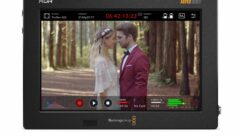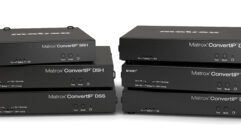
Video Review: Hitachi CP-X10000
Apr 10, 2009 12:00 PM,
By Jeff Sauer
Large-venue projector provides the right combination of price, performance, and features.

Large-venue installation projectors have a reputation for carrying hefty price tags and for having the portability of boat anchors. In the past, they’ve needed both heavy dollars and chassis weight to deliver the much-needed brightness and image quality that large spaces demand. Yet Hitachi has just introduced three new Professional Series large-venue projectors that take a bite out of both reputations.
The new XGA-resolution CP-X10000 is the most traditional of Hitachi’s new threesome, and it is rated at 7500 ANSI lumens. The CP-WX11000 is a native widescreen data projector rated at 6500 ANSI lumens with a 1280×800 resolution, and the CP-SX12000 features a native 4:3 resolution of 1400×1050 and 7000 ANSI lumens. The unifying features of the trio are a commitment to low cost of ownership from a large-venue installation projector and a chassis that weighs less than 30lbs.
That begins with low initial pricing for a large-venue projector and lower longer-term maintenance costs and overall cost of ownership. Each of the three is expected to have an estimated 10,000 hours of maintenance-free operation thanks to a dust-resistant cooling system. Tangibly, eliminating dust means that the air filter needs changing far less often, and it contributes more generally to longer life of other system components, including the LCD panels and filters. With an Ethernet connection built-in, these projectors further assist administrators by emailing reminders of lamp and filter hours when they are close to needing replacement, thus allowing for planned maintenance rather than reactionary repairs. Hitachi’s PJLink software allows for remote administration and monitoring.
In addition to the RJ-45 network connection, the chassis’ back panel includes a full array of AV and control ports. For data, there’s a DVI-D input, two 15-pin RGB inputs and one output, and one set of five BNC ports for RGBHV. That same BNC set can be used for component video—although there’s a dedicated set of three RCA ports for component, a BNC port for composite, and an S-Video port. There’s even an HDMI port for connecting a DVD or Blu-ray player as a video source. For additional control options, there are ports for both RS-232 and a wired remote.
Security functions include an onscreen password function that can be set to lock out unauthorized users from making configuration changes and a PIN-code lock-out that can completely prevent the projector from being used at all. What’s more, a built-in transition detector can sound an alarm if the projector has been physically moved since it was last turned on. Of course, as with any projector, the best theft deterrent is a physical restraint, and Hitachi has included a security bar for use with a cable. It also includes a slot for a Kensington lock.
Other helpful installation features include keystone correction—both automatic and manual—and seven image presets that account for different lighting conditions and projection surfaces. Hitachi’s menu structure allows you to drill down into the color, gamma, and active-iris settings, as well as overscan, positioning, color space, and image processing. That might get complicated if you’re switching back and forth between source types, but that’s not necessarily so with the CP-X10000 or one of its siblings. The My Memory feature allows you to save up to four specific configuration settings and recall them with a click of one of four dedicated buttons. The My Screen feature allows you to capture and store a custom startup screen image.
Picture-in-picture and picture-by-picture used to be common data-projector features in installation models and small travel projectors, but price competition has all but eliminated picture-in-picture as a standard feature. Admittedly, it’s been a sparingly used feature, and leaving it out can save on the cost of materials. However, it can also be handy in more modest installation environments that don’t have the luxury of a separate presentation switcher or a second video display. Hitachi goes halfway, supporting picture-by-picture but not a picture-in-picture inset, which means you’ll have an option for displaying a motion image of a speaker next to, for example, presentation visuals without the substantial cost increase of full picture-in-picture.
Video Review: Hitachi CP-X10000
Apr 10, 2009 12:00 PM,
By Jeff Sauer
Large-venue projector provides the right combination of price, performance, and features.
The other features in the three new models are an active-iris-driven contrast ratio of 2500:1 and high-quality image processing, including 12-bit digital gamma and 10-bit signal processing—which matches the image caliber of some higher-end home-theater projectors.
I tested the CP-X10000 with the standard medium-throw lens, but Hitachi offers five other lens options ranging from 0.5-0.6 for the ultra-short-throw USL-801 lens to the ultra-long-throw UL-806 lens with a ratio of 5-9.2. All have powered focus and zoom, and all but the ultra-short-throw lens offer both vertical and horizontal lens shift. Each of these lenses adds a good 25 percent to the weight of the chassis, yet that still keeps the CP-X10000 at a convenient weight for lifting and mounting.
Related Links

Corporate AV Projection and Flatpanel Trends
Projectors and flatpanel displays are the centerpiece to many corporate AV installations. According to Dr. Jeffrey Macdonald of TFCinfo Corp., the most popular projectors are in the 2100 to 2500 lumen range for value-priced models, and 2600 to 3000 lumens for fuller featured models….

Hitachi Home Electronics introduced the CPX4 3LCD projector, which is designed for portability and reliability with a host of enhanced features…

For this year’s Projection Roundtable survey of industry opinion, the editors of Sound & Video Contractor turned to experts from 12 companies that routinely communicate important announcements to the industry through the Briefing Room as our knowledge pool…
Something for everyone
Hitachi gives the CP-X10000 a brightness specification of 7500 ANSI lumens, and that, like most brightness specs, is exaggerated—in this case by more than 10 percent. I measured a peak brightness of just less than 6700 ANSI lumens with an average in Daytime mode of about 6400 ANSI lumens. On the other hand, brightness uniformity topped a wonderful 93 percent in my tests, and I measured every bit of Hitachi’s 2500:1 contrast and then some.
Naturally, those specs, as well as color accuracy, have a lot to do with configuration. For example, going to Cinema mode drops overall brightness by about 50 percent, but it dramatically increases the color accuracy and the smoothness of the grayscale ramp. In Daytime mode, cyan and yellow are skewed far toward green, which itself is extreme. Blue also moves toward green, but not by as much as the secondaries. Similarly, the Daytime mode grayscale ramp is a serious S-curve with color temperature fluctuating wildly. However, in Cinema mode—and, to a slightly lesser extent, in Normal mode—colors are almost right on, and the grayscale ramp is a nice smooth curve. Those differences in measurements are certainly to be expected, albeit usually not quite as pronounced.
Still, the CP-X10000 is affordable by large-venue standards and offers a wonderful combination of user-friendly features and sophisticated installation options. Although there’s a choice between its highest brightness output and its top color performance, the overall package makes it an excellent choice for a wide range of venues.
PRODUCT SUMMARY
- Company: Hitachi
www.hitachi.us - Product: CP-X10000
- Pros: Excellent contrast; good brightness; relatively small chassis for a large-venue projector; price.
- Cons: Wide range of color and grayscale accuracy depending on setup.
- Applications: Large venues.
- Price: $14,999 (including standard lens)
SPECIFICATIONS
- Brightness: 7500 ANSI lumens
- Contrast: 2500:1 full on/off
- Native resolution: XGA (1024×768)
- Configuration: 3×1.3in. TFT LCD
- Light source: 350W UHB lamp (rated 2000 hours in Normal mode, 3000 hours in Eco mode)
- Lens options: Six powered lens options (0.5-0.6 short throw to 5-9.2 long throw)
- Standard lens: F1.6-2.2, f=60mm-78mm, zoom 1.3:1
- Projection distance: 5.6ft.-136.9ft.
- Screen size: 40in.-700in. diagonal
- Throw ratio: 2.2-2.9
- Keystone: ±40° vertical, ±20° horizontal
- Lens shift: 3.7:-1/-1:3.7 vertical, 1.3:-1/-1:1.3 horizontal
- Dimensions: 18.7″x10.7″x18.5″ (WxHxD)
- Weight: 28.9lbs. (no lens)
- Warranty: Three years parts and labor, 120 days lamp










